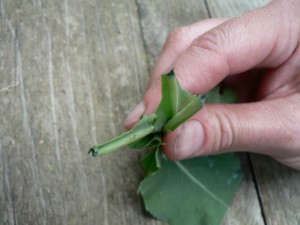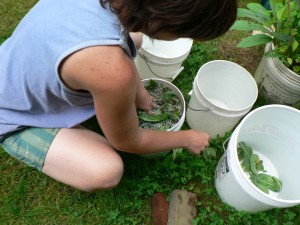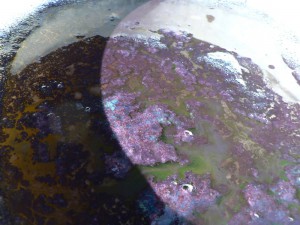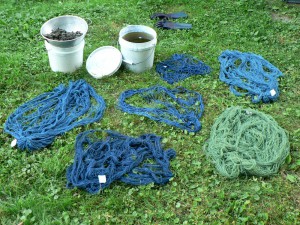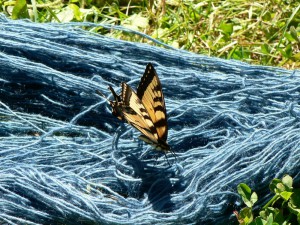This summer I have spent most of my time and energy on weaving, but I didn’t want to let the summer end without at least a little bit of dyeing. So, last Friday I ran a woad vat, following my usual routine based on Rita Buchanan’s directions in A Dyer’s Garden and A Weaver’s Garden. The woad plants in the bed that self-sowed, and the transplants from that bed, were still pretty small. I lost about half of the plants in the bed affected by club root, which left one short bed with decent-sized (though a bit moth-eaten) leaves. I picked from all the beds, and collected two and a half pounds of leaves. I was worried that there wouldn’t be much color in the leaves yet because they were still small, but you can see the “breaking blue” as it oxidizes here on the cut stems:
This is always a good sign. Here I am rinsing off the leaves.
They only filled a 2 gallon bucket rather than my usual 5 gallon, so after I extracted the leaves, I adjusted the amounts of ammonia and RIT Color Remover accordingly. I still haven’t ordered pH strips, but it’s pretty easy to tell when the pH is right because the color shifts to an amazing murky green when you add enough ammonia. I used a generous 3/4 cup of ammonia, aerated vigorously, and then sprinkled on 2 tablespoons of RIT Color Remover. I have sometimes used Thiox instead for the reducing agent, but even though I hate the smell of the RIT product, I am happier with my results from it. Specifically, the color bonds better to the fiber and less rinses off, and there is less residual odor after the skeins are rinsed and dried.
Here’s the surface of the vat after it reduced.
I was very excited by the purple-blue iridescence on the surface. I don’t always get this with a woad vat, even on a vat that yields great color. Below the surface you can see the greenish-yellow of the reduced vat, ready to use.
First, I over-dyed some cotton and cotton-linen blend skeins, previously dyed with woad, to get a darker color. If I’m doing both cellulose fibers and protein fibers in the same vat, I dip the cellulose fibers first. Cellulose is just harder to dye, no matter what you do, and it needs all the help it can get. Wool will gobble up all the color if you put it in first, leaving slim pickin’s for the cellulose. Then I over-dyed some blotchy and pale wool skeins, also previously dyed with woad. Lastly I over-dyed the two yellow skeins from my demo at the Massachusetts Sheep and Woolcraft Fair, dyed with tansy.
Here are some of the yarns spread out on the grass to oxidize.
We were visited by a lovely swallowtail who stuck around for quite a while and let me get some good shots.
I always do a delayed rinse with my yarns, which means I let them dry completely before rinsing. Today, more than a week later, I am rinsing the skeins. It is so humid at the moment I will have to put a fan on them to help them dry.

